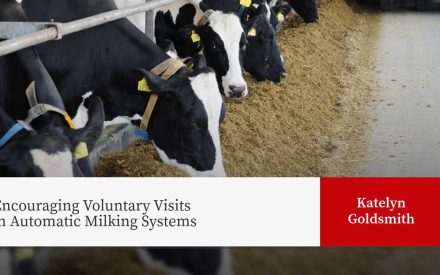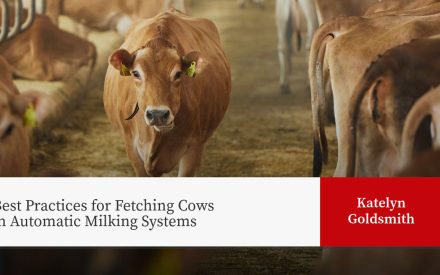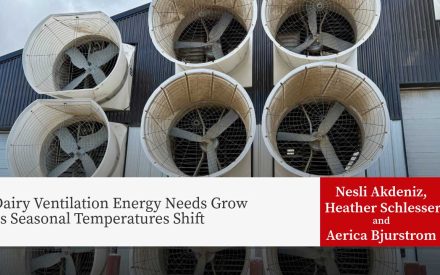Preventing new mastitis cases and treating existing cases is essential to excellent milk quality.
Mastitis is the most frequently diagnosed and treated disease in dairy herds. Mastitis is an inflammation of the mammary gland and most of the cases are caused by bacteria. This disease is associated with negative impacts on milk production and quality, and profitability. Prevention of new cases of mastitis and treatment of existing cases is extremely important to maintain excellent milk quality. Management of mastitis remains a high priority in conventional and (automatic milking systems) AMS. Clearly, there are some differences in management of mastitis between conventional and AMS. To make sure that abnormal milk does not enter the raw milk supply system1, conventional dairy herds use visual inspection (e.g., clots, flakes, or watery milk) and AMS use bio sensing systems—changes in electrical conductivity, for example. Detection of abnormal milk is just one difference between both systems and dairy farmers need to understand that management strategies to prevent and/or control mastitis might differ between conventional and AMS system.
Context
In November 2019 we received a call from a farm with concerns about the level of mastitis in their herd. The farm installed 2 AMS (robotic milking) about 3 years prior, at which time they also built a new 3-row, sand-bedded freestall barn with drive-through feeding.
In late 2018, they started treating more cows for mastitis and reported a poor recovery rate. They defined recovery as absence of abnormalities in milk. Mastitis detection methods consisted of identifying cows with high milk conductivity followed by manual striping and observation of any visible signs of abnormal milk or udder inflammation. Cows identified as having visual signs of mastitis were treated with an intramammary ceftiofur product without knowing the etiology of the mastitis-causing pathogen.
The farm was not initially conducting monthly individual somatic cell count (SCC) testing because they did not have access to an automated sample collection device. In September 2019 they were able to locate a sample device and started measuring SCC of the whole herd monthly. They observed that several cows with high SCC (≥200,000 cells/mL) did not register high conductivity levels.
The farm had been in contact with the milking equipment service personnel and their veterinarian to address the high SCC issue. In December 2019, the farmer reached out to Extension to help investigate this mastitis problem.
Milk quality situation
Monthly average Bulk tank SCC was consistently greater than 200,000 cells per mL since December 2017 and data for December 2019 is shown in table 1. The level of bulk tank SCC indicated that some cows were experiencing intramammary infections.
Bulk tank cultures indicated that both standard plate count (SPC) and preliminary incubation (PI) increased between August and November 2019 (figure 1). An inappropriate water temperature for AMS cleaning was identified and resolved after which the SPC and PI counts returned to normal values.
In March 2019, the farmer sent three bulk tank milk samples for microbiological diagnosis. These cultures identified the presence of Staphylococcus aureus and Streptococcus agalactiae meaning that the herd had one or more cows infected with contagious pathogens. The total number of noncontagious bacteria was also identified as an issue with environmental mastitis resulting from stall hygiene and/or udder preparation during milking.
TABLE 1. Bulk tank SCC in December 2019.
| Test Date | Bulk tank SCC |
| 12/02/2019 | 284,000 |
| 12/04/2019 | 219,000 |
| 12/06/2019 | 270,000 |
| 12/08/2019 | 213,000 |
| 12/10/2019 | 250,000 |
| 12/14/2019 | 265,000 |
| 12/16/2019 | 298,000 |
| 12/18/2019 | 236,000 |
| 12/22/2019 | 311,000 |


We estimated the prevalence of subclinical mastitis (SM) from individual cow SCC tests (single SCC test ≥200,000 cells/mL) as 24% to 49% of cows between September and December 2019. During this period 26% of cows experienced chronic SM (two consecutive SCC tests ≥200,000 cell/mL). Our goals for the prevalence of SM is <15% of cows and for chronic SM <5% of cows2.
We concluded that there were issues with both contagious and environmental mastitis and scheduled a farm first visit to gather more information.
Farm visit
We conducted the following activities:
- Udder hygiene scoring of all cows using the scoring system3 recommended by Dr. Pamela Ruegg. 83% of cows were scored as 1 or 2 and 17% of cows were scored as 3 or 4. Ideally no more 10% of cows should be classified as 3 and 44.
- California Mastitis Tests (CMT) was performed in all quarters of cows identified as having SM (n=21), chronic SM (n=12), and fresh (n=1). Overall, we sampled 29% of the herd, and all sampled cows had at least one CMT positive quarter. Milk samples were taken from CMT positive quarters and submitted for microbiological analysis. Quarter microbiology indicated that 76% of samples were positive for bacterial growth and 46% of cows sampled were infected with contagious pathogens (figure 2).
Our recommendations
- Perform SCC tests on all cows.
- For cows with high SCC counts (≥200,000 cells/mL), collect milk samples from CMT positive quarters and perform culture analysis to determine the pathogen type. Resample these quarters 3 to 4 days after initial sample if no bacteria are found.
- For fresh and low SCC cows, collect 3 series of composite (4 quarters) samples every 3 to 4 days to ensure you have not missed any infected cows. Discuss with your herd veterinarian fine tuning of this sampling strategy.
- Send milk culture samples to the Wisconsin Veterinary Diagnostic Laboratory or other certified lab for microbiological analysis.
- Develop a method to segregate and/or cull cows infected with Staphylococcus aureus.
- Develop an individual cow mastitis treatment protocol based on microbiological results of in consultation with the Herd veterinarian. Antimicrobial therapy can be successful against Streptococcus agalactiae but not Staphylococcus aureus.
- Continue assessing intramammary status by using results from bulk tank microbiological analysis and SCC measurements from the AMS. Talk with your herd veterinarian to develop a plan to monitor intramammary status by using both data.
- Improve stall maintenance to improve cow cleanliness, especially lower legs, and udder. Use udder hygiene scoring to assess progress.
- Perform routine checks and maintenance of AMS and associated equipment to ensure proper function.
Adjustment of farm management practices
The barn and pen configuration made it difficult to isolate infected cows. Modifications were made to the barn to enable splitting the herd into two groups. Efficient use of the AMS required that the number of cows in each group be approximately equal. The number of cows infected with contagious mastitis were more than half of the herd so aggressive culling of these cows was done at the time of group creation. The farm continued to monitor, and cull cows infected with contagious mastitis from that group.
An automated SCC measurement system was installed on each of the AMS to aid in monitoring the mastitis status of individual cows in the herd. The farm plans to continue perform microbiological testing of the bulk tank and individual cows to identify types of mastitis pathogens and aid in treatment decisions.
Take home messages
- Continuous monitoring of individual cows and bulk tank milk is necessary to identify the types and prevalence of mastitis in any herd.
- Pre and post milking sanitization can be performed with AMS technology. Both have several levels of intensity and should be adjusted according to the general cleanliness of udders in the herd. Sanitization will reduce but not eliminate the transfer of contagious mastitis pathogens. It is still necessary to monitor the herd to detect the presence of contagious pathogens.
- Keeping stalls clean and dry—and thereby udders and teats clean—is the first line of defense for environmental mastitis. Periodic udder hygiene scoring is a good way to assess the effectiveness of stall and bedding maintenance.
- Some AMS barn designs make it difficult to create isolated groups of cows, should the need arise. Consider this when designing an AMS barn.
References
- Robotic Milking: Current Situation. Doug Reinemann. https://milkquality.webhosting.cals.wisc.edu/wp-content/uploads/sites/212/2011/09/robotic-milking-situation.pdf
- Key performance indicator: Subclinical Mastitis. Pamela L. Ruegg. https://milkquality.wisc.edu/wp-content/uploads/sites/212/2011/09/Key-Performance-Indicator-subclinical-mastitis.pdf
- Udder Hygiene Scoring Chart. Pamela L Ruegg. https://milkquality.wisc.edu/wpcontent/uploads/sites/212/2011/09/udder-hygiene-scoring-chart.pdf
- A Toolbox for Assessing Cow, Udder and Teat Hygiene. Nigel Cook and Doug Reinemann. https://milkquality.webhosting.cals.wisc.edu/wp-content/uploads/sites/212/2011/09/toolbox-for-assessing-cow-udder-and-teat-hygiene.pdf

 Milking in Conventional Systems vs. Automated Systems—What is the Difference?
Milking in Conventional Systems vs. Automated Systems—What is the Difference? Encouraging Voluntary Visits in Automatic Milking Systems
Encouraging Voluntary Visits in Automatic Milking Systems Best Practices for Fetching Cows in Automatic Milking Systems
Best Practices for Fetching Cows in Automatic Milking Systems Dairy Ventilation Energy Needs Grow as Seasonal Temperatures Shift
Dairy Ventilation Energy Needs Grow as Seasonal Temperatures Shift


